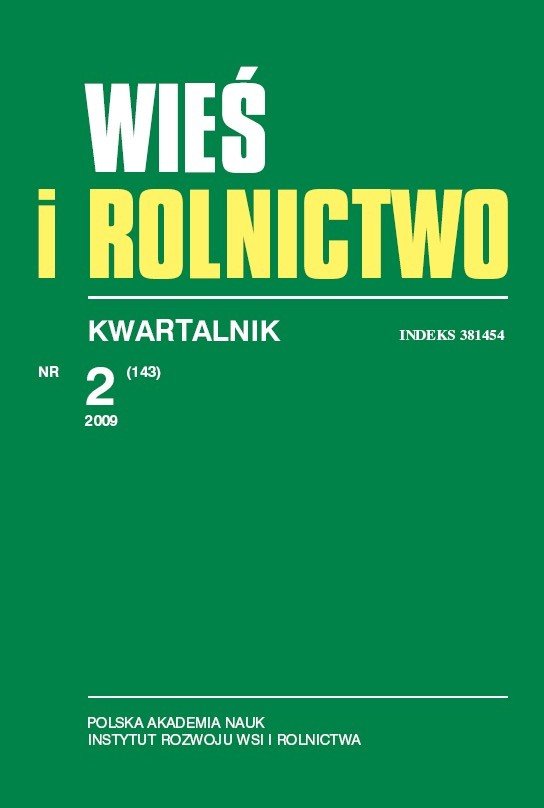The Impact of Cohesion Policy on Economic and Social Integration in EU in 1988–2008
DOI:
https://doi.org/10.53098/wir.2009.2.143/05Keywords:
European Union, cohesion policy, structural funds, Cohesion Fund, member-states, effects of cohesion policyAbstract
The cohesion policy was adopted in 1988 with the purpose of reducing disproportions in the level of development of various regions of the Community's countries, and eliminating the backwardness of the underprivileged areas, rural areas included. In accordance with decisions taken at the time the cohesion policy was to be financed from structural funds, i. e. from the Orientation Section of FEOGA (the European Agricultural Guidance and Guarantee Fund), the European Regional Development Fund, the European Social Fund and — from 1993 — the Financial Instrument for Fisheries Guidance and, also, the Cohesion Fund. Since 1988 the cohesion policy has been modified several times (in 1994-1999, 2000—2006 and 2007—2013). In the 1988—2006 period the main beneficiaries of assistance available from the EU funds were the poorest member-states of the European Union — Spain, Greece, Portugal and Ireland. These countries allocated the obtained means to the development of infrastructure, human resources and production environment. The use of means obtained from the EU funds in 1988—2006 helped reduce the difference in the le-vel of development of the named countries and the remaining countries of EU-15.References
Aby rozszerzenie stało się sukcesem, 2008. „inforegio panorama” 26.
Beutel J., 2002: The Economic Impact of Objective1 Interventions for the period 2000–2006. Final Report to the Directoriate General for Regional Policies European Commission.
Bielecki J., 1999: Polska jak grecki Ipeiros. „Rzeczpospolita” z dnia 4 lutego.
Bielecki J., 2000: Największa poprawa od lat. „Rzeczpospolita” z dnia 12 września.
Bujnowski M., 2009: Polityka spójności UE i jej realizacja w Polsce. W: Polityki gospodarcze Unii Europejskiej. Red. E. Kawecka-Wyrzykowska. Szkoła Główna Handlowa w Warszawie, Warszawa.
Czykier-Wierzba D., 2003: Finansowanie polityki regionalnej w Unii Europejskiej. Twigger, Warszawa.
Czykier-Wierzba D., 2005: Wykorzystanie środków z funduszy strukturalnych Unii Europejskiej w regionach objętych celem 2 w latach 1994–1999. „Bank i Kredyt” 1.
Die Strukturfonds in 1994. Sechster Jahresbericht, 1996. Europäische Kommission, Luxemburg.
Die Strukturfonds in 1998. Zehnter Jahresbericht, 1999. Europäische Kommission, Luxemburg.
Europa im Blick der Statistik, 2000. Eurostat Yearbook 2000, Luksemburg.
European Economy, 1998. European Commission, Convergence Report.
European Economy, 2002. European Commission, Luxembourg. Europe in Figures, 2008. Eurostat Yearbook 2008, Luxembourg.
Facts through Figures. A statistical portrait of the European Union, 1996. Eurostat Yearbook 1996, Luxembourg.
Growing Regions, Growing Europe, 2008. Fifth progress report on economic and social cohesion. European Commission, Luxembourg.
Hübner D., 2008: Regiony są ważne. „inforegio panorama” 26.
Kawecka-Wyrzykowska E., 2000: Znaczenie funduszy pomocowych dla Polski jako członka Unii. W: Znaczenie funduszy pomocowych Unii Europejskiej dla Polski. Szkoła Główna Handlowa, Warszawa.
Kawecka-Wyrzykowska E., 2007: Cele i zasady polityki spójności w Unii Europejskiej. W: J. Barcz, E. Kawecka-Wyrzykowska, K. Michałowska-Gorywoda: Integracja europejska. Oficyna a Wolters Kluwer business, Warszawa.
Key Figures on Europe, 2008. Eurostat Yearbook 2007/2008, Luxembourg.
Konsolidacja i podwojenie wysiłków, 2008. „inforegio panorama” 26.
Nowe partnerstwo dla spójności: konwergencja, konkurencyjność, współpraca, 2004. Trzeci raport na temat spójności gospodarczej i społecznej. Komisja Europejska, Luksemburg.
Objective 1 assistance indirectly benefits non-objective 1 areas, 2002. „Inforegio news” European Union 101.
Od projektów do programów, 2008. „inforegio panorama” 26.
Pietrzyk I., 2000: Polityka regionalna Unii Europejskiej i regiony w państwach członkowskich. Wydawnictwo Naukowe PWN, Warszawa.
Polityka spójności 2007–2013, 2007. Komentarze i teksty oficjalne. Luksemburg.
Radzymińska T., 1999: Integracyjna solidarność. „Nowe życie Gospodarcze” 9.
Rozporządzenie Rady (EWG) nr 2052/88 z dnia 24 czerwca 1988 (Dz.Urz. WE L 185 z dnia 15.7.1988).
Rozporządzenie Rady (WE) nr 1083/2006 ustanawiające ogólne przepisy dotyczące Europejskiego Funduszu Rozwoju Regionalnego, Europejskiego Funduszu Społecznego oraz Funduszu Spójności i uchylające Rozporządzenie (WE) nr 1260/1999 (Dz. Urz. UE L 210/25 z 31.07.2006).
Rozwijające się regiony – rozwijająca się Europa, 2007. Czwarty raport na temat spójności gospodarczej i społecznej. Komisja Europejska, Luksemburg.
Spojrzenie na rok 1988, 2008. „inforegio panorama” 26.
Statistische Grundzahlen der Europäischen Union, 1995. Eurostat Jahrbuch 1995, Luksemburg.
Unity, solidarity, diversity for Europe, its people and its territory, 2001. Second report on Economic and Social Cohesion, Luxembourg.
Wach K., 2006: Systemy podatkowe krajów Unii Europejskiej. Oficyna Ekonomiczna, Kraków.
Wydatki polityki spójności 1989-2013, 2008. „inforegio panorama” 26.
Wzrost i zatrudnienie, 2008. „inforegio panorama” 26.
Zientara P., 2008: Europejska polityka spójności: kontrowersje i wątpliwości. „Wspólnoty Europejskie” 4.
Downloads
Article file downloads
Pages
How to Cite
Issue
Section
License
Copyright (c) 2009 Wieś i Rolnictwo

This work is licensed under a Creative Commons Attribution 4.0 International License.










